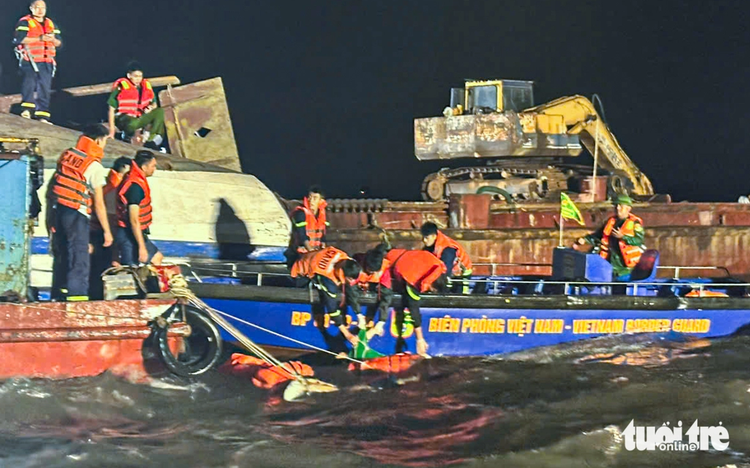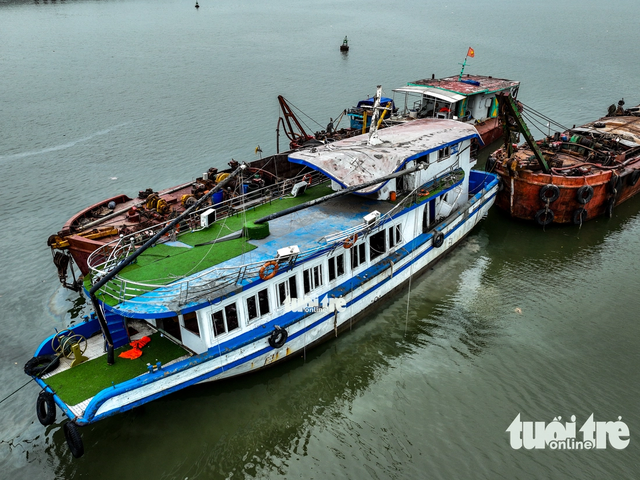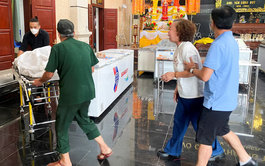
Rescuers search for victims of the tourist boat capsizing incident in Ha Long Bay, Quang Ninh Province, northern Vietnam, July 19, 2025. Photo: Viet Anh
They urged the public not to blame the victims, noting that such accidents are unpredictable and unintentional.
Before the incident, the weather in the area was reportedly calm and sunny.
The tourist boat, carrying 49 people, capsized in Ha Long Bay on Saturday afternoon.
Of the 49, 35 have been confirmed dead, four remain missing, and only around 10 people survived.
Authorities are racing against time to continue search and rescue operations before worsening sea weather conditions due to the approaching storm Wipha.
The incident has left the public in shock and grief.
Amid widespread sorrow, social media has seen divided opinions. Some users questioned, "Why did they go out to sea when a storm was forecast?" and "Why didn’t they postpone the trip to ensure safety?"
Others were more critical, calling the decision to travel during thunderstorm formation reckless.
On the other hand, many expressed frustrations toward local authorities, questioning why the boat was allowed to depart despite warnings of bad weather.
Still, many voices called for empathy and understanding, emphasizing that the weather was clear and sunny before the incident happened.
Local authorities later attributed the cause of the incident to a sudden thunderstorm triggered by a tropical convergence zone and prolonged heat, not storm Wipha, as some initially speculated.
Victims were not at fault
Responding to the growing debate, on Sunday evening, Dr. Nguyen Ngoc Huy, a weather and extreme disaster warning expert, published an analysis of the incident.
He clarified the circumstances surrounding the sudden storm and affirmed that the victims of the Ha Long Bay boat capsizing were not at fault.
He stated that the tourists boarded the boat around noon, at a time when the weather was hot and sunny with no signs of rain or strong winds.
Official storm warnings also stated that storm Wipha would only reach the Gulf of Tonkin on Monday.
“If I had been a passenger, I would have boarded the boat as well. Therefore, it's unfair to blame the victims for going on the trip,” Huy noted.
Regarding some netizens wondering why authorities did not issue a sailing ban, Huy explained that the decision to prohibit boats from going out to sea must be based on official weather forecasts or the direct observation of local weather conditions.
The official weather bulletin on Saturday morning forecast wind levels at only level two to three. An updated weather bulletin at 1:30 pm reported rain and thunderstorms. By that time, the boat had already departed, and port authorities subsequently halted the departure of all other vessels.
As a general practice, a sailing ban may be issued when a storm is expected to approach land within 24 hours, to ensure vessels have time to return to port and anchor safely.
Since storm Wipha was only forecast to reach the Gulf of Tonkin on Monday, it would not have been appropriate to issue a sailing ban as early as Saturday—unless there was a clear detection of extreme weather conditions, according to Huy.
Authorities reported that during the rescue operation, 80-90 percent of the victims were found wearing life jackets. This indicates that the boat’s captain had likely issued an order for his passengers to put them on.
However, wearing a life jacket inside an enclosed cabin poses a danger, as it makes it more difficult to move and escape. Ideally, once life jackets are on, passengers should be on the deck, or all windows should be opened.
Huy suspected that when heavy rain and strong winds hit, the passengers closed the windows to prevent water from getting inside the cabin. That likely prevented them from escaping when the boat capsized.

The tourist boat is towed back to the port in Ha Long Bay, Quang Ninh Province, northern Vietnam, July 20, 2025. Photo: Nam Tran / Tuoi Tre
On Saturday night, another passenger boat offering squid fishing services capsized off the coast of Thien Cam in Ha Tinh Province, north-central Vietnam and 34 people fell into the sea.
All of them were rescued safely, most likely because it was an open boat, the passengers were outside, and they were all wearing life jackets.
Thunderstorm forecasting remains a challenge
Many netizens asked why there was no early thunderstorm warning.
In response, Huy explained that both major forecasting models—GFS from the United States and ECMWF from Europe—did not predict any thunderstorms over Ha Long Bay during the time frame from 12:00 pm to 2:00 pm on Saturday.
Huy noticed the thundercloud formation on satellite imagery at around 2:00 pm, but by that point, it was already too late.
Initially, the cloud cluster was very small, located in the northern part of the Gulf of Tonkin, and gradually expanded. If there had been continuous and early monitoring, the development trend of the thunderstorm might have been anticipated.
However, the area where the boat capsized experienced extremely rapid thunderstorm development, making early warnings hard unless someone was physically present to observe it in real time.
Radar imagery from upper-air meteorological stations can detect thunderstorms, but like satellite images, they only reflect current conditions. This means that by the time a thunderstorm is detected, it has already begun forming.
At the time of the thunderstorm, surface air pressure was extremely low due to prolonged heat and low-pressure conditions over several days. When this low pressure combined with high ground temperatures and met cold upper-level air converging along a narrow band, thunderstorms were certain to form.
However, to measure temperature and air pressure at upper levels (from 1,500 meters and above), weather balloons are required. Each balloon launch costs over US$1,000, making it financially unfeasible to launch them daily.
As a result, thunderstorm forecasting remains relatively uncertain. It is difficult to predict such events far in advance or to accurately forecast wind intensity.
The thunderstorm on Saturday afternoon was an extremely rare and powerful convective cloud formation, sweeping from north to south. This was an uncommon meteorological scenario.
The boat capsizing incident was also a rare event and could have involved a localized tornado. In such a case, even a modern boat with an experienced captain would have had no way to respond effectively.
Some suggested that passengers had asked the captain to return to port, but he continued toward the sightseeing destination. In this situation, it was possible the captain had assessed the route and determined that reaching the nearest destination would take less time than turning back. If so, choosing to proceed was a logical decision, not a reckless or careless one, according to Huy.
Heading for the closest point was the right choice. The captain was also a victim in this tragedy and did not abandon the boat when the accident occurred, the weather expert added.
Many readers of Tuoi Tre News agreed that the tragedy was unpredictable as before the incident, it was sunny.
Reader TL Minh Thu wrote that “this is another storm that was unpredictable even though the weather forecast didn't know it would come.”
According to Jellyfish LunaLye, this was not a storm but a thunderstorm, it happened suddenly, and no one could have predicted it.
“They were TRAPPED INSIDE THE SHIP, using life jackets at this time would be useless. You must know that in Ha Long, at 13:30 it was still sunny, but only 30 minutes later the thunderstorm started. Everyone tried to move to the bridge, only 5km left but it was too late. The boat capsized at 14:05.”
John Krumins, another reader, shared the same view, saying, “That weather hit very suddenly. I am here in the city, and it was totally unpredictable. Everyone saying it was forecasted days in advance is mistaken, they’re thinking of the coming typhoon that is expected to hit very soon.”
Many others called on others to stop blaming the casualties as evidence shows it was an unexpected thunderstorm, not a forecast storm.



Max: 1500 characters
There are no comments yet. Be the first to comment.